By Ellen Even and Armin Sieber for Enlivening Edge Magazine
This article is part of a two-part article, and each part is understandable on its own, in either order. A more complete picture of the school requires reading both parts.
Introduction by Jean-Paul Munsch, Guest Editor of EE Magazine’s Education edition:
Beyond every essential technical reflection and needed theoretical foundation described, this article offers you a personal story and another insight into itw—probably one of the “Tealy-est” schools around. Presence, need-orientation, solution-focus, and connectedness are the keywords for this sincere story of successful and meaningful relationships between adults and kids.
Introduction
The Integral Dayschool (Integrale Tagesschule, itw) in Winterthur, Switzerland, is a small private school with approximately 32 students spread over 3 age-mixed learning teams. In recent years the school has managed to turn the challenge of having students with very diverse and often challenging backgrounds into growth opportunities and to develop the school into a dynamic and flexible learning organization.
An important turning point for the teacher team was when it developed a sense of how to integrate some of the ideas of Teal into daily practice and develop parts of the Teal mindset into a clear vision and focus for the entire school team. For many teachers, this led to a clarity and a sense of belonging which made it possible for the entire team to positively engage in an ever-changing and growth-oriented but complex learning process.
At itw we’ve created an experience we call ‘Line-of sight-sailing’, by which we mean staying in the present, looking for needs and being flexible. These are qualities of a Teal mindset which make it easier for teachers to deal with difficult situations. Furthermore, keeping an open mind and looking for opportunities and solutions instead of focusing on the problem has resulted in many cases in turning very challenging situations into success stories for teachers, students, and even parents. Making students a part of the solution-oriented process has proven to play an important role as well.
As anyone who has ever gone sailing knows, more skills are needed than navigating alone. A true captain knows the strengths of the crew members and knows when the time has come to act. Especially when the waves get bigger and the boat enters a storm; there are a range of skills one might find helpful in order to keep control over the boat. Some of the most important skills a wise leader of a boat crew could use can be summarized using the colors of the Spiral.

We found that these skills, needed at sea, can be used as very comprehensible metaphors for classroom management. We will use them in this article to describe some of the teacher-student interactions we have found helpful and powerful when dealing with difficult classroom situations at our school.
Line-of-sight sailing for meaningful and powerful teacher-student interactions: an example of connection-oriented intervention
Let’s start with a very short and simple classroom situation most teachers can relate to.
“Leon and Noah are talking rather loudly about a weekend activity they are planning together. While doing this, they are not working on the task they are expected to be doing. Mrs, Riesen, their Mathematics teacher, feels the need to intervene.”
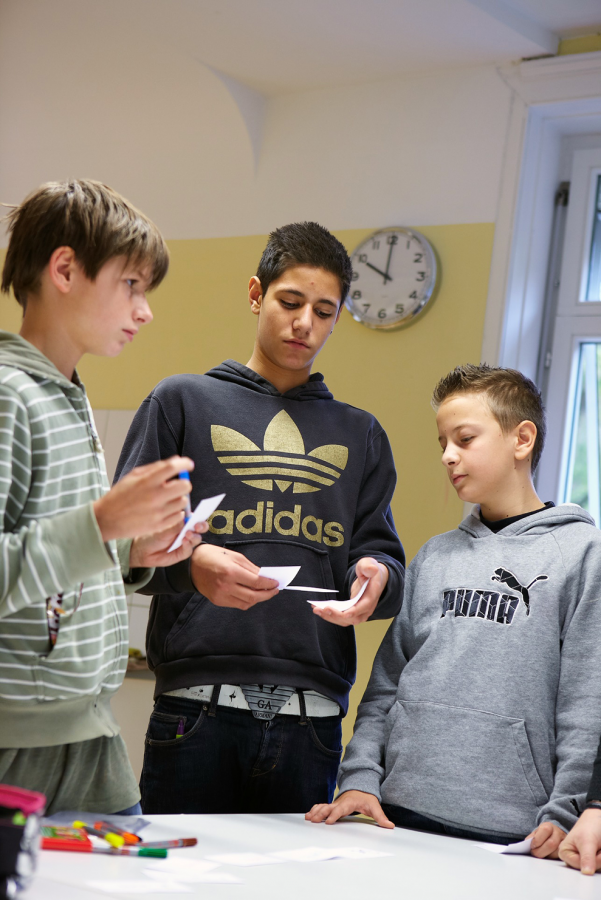 Although we can say without hesitation there are thousands of conscious and subconscious factors influencing the interactions between teachers and their students, in this article we will focus on something we believe has a huge impact on the chances of the boat making it through the storm: the teacher’s mindset and some concrete tools from itw, used to enhance a positive interaction between teacher and student during an intervention.
Although we can say without hesitation there are thousands of conscious and subconscious factors influencing the interactions between teachers and their students, in this article we will focus on something we believe has a huge impact on the chances of the boat making it through the storm: the teacher’s mindset and some concrete tools from itw, used to enhance a positive interaction between teacher and student during an intervention.
Intervening from a needs-based Teal perspective
When the sea gets rough, a first helpful way to deal with it, before any intervention takes place, is for the captain to open his/her eyes, build an overview of the situation, and find where the challenges lie. In a classroom. it’s important as well to first take a step back, before one too-hasty intervention puts the boat in a direction the teacher might not want to be headed.
A possible way to coach and intervene from a Teal perspective could be for Mrs. Riesen to take an inner walk through the different stages of development of worldviews (represented by colors) of the Spiral of consciousness development (Spiral Dynamics: Mastering Values, Leadership and Change, by Christopher C. Cowan and Don Edward Beck, 1996). This would imply her having to let go of her own preference for one or more specific colors, leave her own comfort zone, and detect the different needs of her students in every color possible:
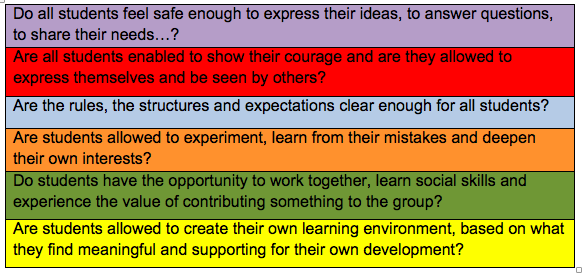
In this case, Mrs. Riesen would reflect on whether either Leon or Noah has the need for more or less of a certain developmental stage’s mindsets in the specific task given. She would address this need, and if her analysis were correct, the boys would now start with their task.
For example, Mrs. Riesen knows that Leon feels safe in her classroom and is accepted by all other students (Purple). She also knows that he is capable of doing the task because he is usually good in these sorts of tasks (Orange). She also knows that Leon understands the rules and knows what the expectations are for the task (Blue). Furthermore, Mrs. Riesen knows that Leon has a big need to live his ‘Red’ side and she wants him to be able to do so in a healthy way. Based on this short reflection, she asks him to show his results in front of the classroom at the end of the lesson. This requires Leon to show courage and allows him to be in the center of attention in a positive way; both are expressions of a Red developmental stage of worldview. Leon might see this as an important motivational driver for him to start again with his task and also let Noah do his work.
Line-of-sight sailing, in this case especially staying in the present, looking for needs and being flexible led to one small intervention which did not negatively impact the teacher-student connection, but—on the contrary—helped Leon. Even though Mrs. Riesen had to let go of her carefully planned lesson set-up (she had planned to share the results of the task herself and now has to change this plan last minute), she realized that this intervention was more meaningful than sticking to her original plan.
Shaping meaningful interactions through line-of-sight sailing
What would have happened if Mrs. Riesen’s analysis wasn’t right and Leon didn’t go back to work? Maybe addressing his ‘Green’ side and talking with the two boys about their plans for the weekend for a moment, and sharing their excitement, could have worked? But what if it didn’t?
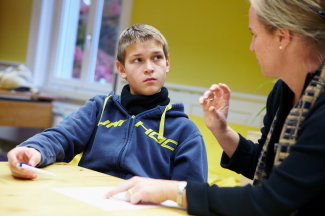 At itw we believe strongly that learning takes place in relationships. A positive connection between teacher and student is a precondition for the best possible form of learning and development to emerge. From the perspective of ‘line-of-sight sailing’, how can positive connections between teacher and student be formed or maintained while strict interventions are necessary in order to be in charge of what happens in the classroom? In our example, how could a positive connection focus help Mrs. Riesen deal with the situation, if her first attempts didn’t work out?
At itw we believe strongly that learning takes place in relationships. A positive connection between teacher and student is a precondition for the best possible form of learning and development to emerge. From the perspective of ‘line-of-sight sailing’, how can positive connections between teacher and student be formed or maintained while strict interventions are necessary in order to be in charge of what happens in the classroom? In our example, how could a positive connection focus help Mrs. Riesen deal with the situation, if her first attempts didn’t work out?
The following Teal-based mindsets and tools have proven important for teachers at itw to keep the connection between teachers and students positive, and as a result to find solutions and learning opportunities in difficult situations.
Negative behavior is always the expression of an unfulfilled need.
At itw we believe that all students’ behaviour reflects a more or less helpful way to express their needs. Understanding why a person reacts in a certain way and believing that this reaction is the result of someone’s capability of either making a choice (being connected to one’s own needs and therefore being able to make decisions) or not making a choice (being disconnected to one’s needs and not knowing what is in one’s best interest) makes it easier for teachers to relate to their students and to keep an open mind and positive attitude towards them.. Understanding leads to a sense of connection, which leads to positive interactions.
This mindset also implies that teachers always have the choice to stay open for, and interested in, other people’s needs, and there is no need to focus on negative behavior and no need to judge others.
Line-of-sight sailing, or more specifically in this case keeping an open and positive mindset, helps teachers see the needs behind students’ behavior and talk about these needs with the student. Trusting the student, the situation, but—most of all—yourself, is a skill that comes with positive experiences. Learning from difficult situations is key to the development of this skill. Trying out new ways of dealing with certain situations and looking for what works best, is something sailors and teachers can both profit from throughout their entire career to keep the ship running.
In our example this would mean that Mrs. Riesen would specifically ask the boys what they need in order to go back to their work, and together try to figure out which unfulfilled need led to the fact that they were not able to work on their task.
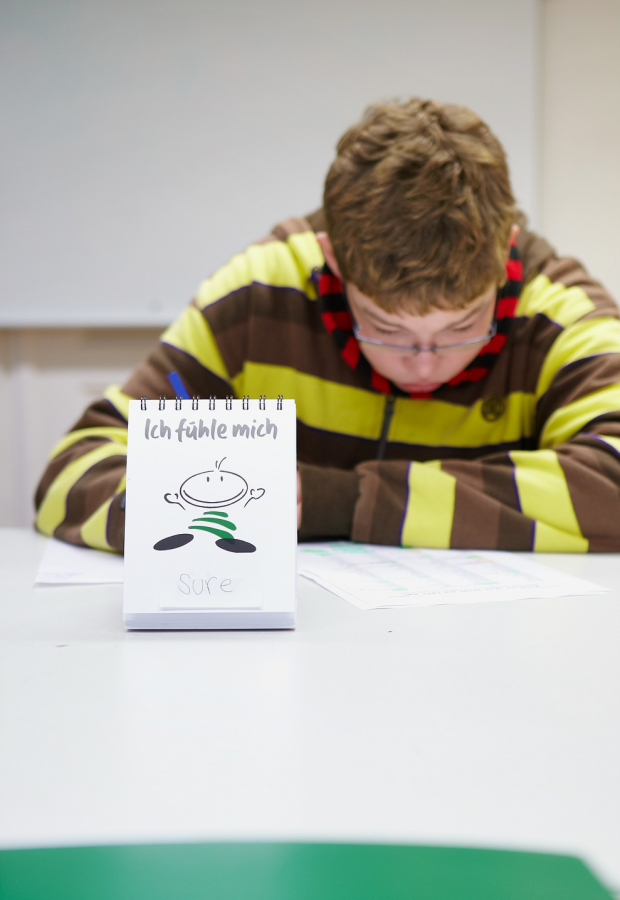 If students are not able to express their needs or to cooperate in finding a solution, meaning they are stuck in an unhealthy or negatively driven ‘Red’, we found at itw that it is most helpful for the relationship between teachers and students to stay in a positive balance, when teachers intervene in a ‘healthy Blue’ way, as described below.
If students are not able to express their needs or to cooperate in finding a solution, meaning they are stuck in an unhealthy or negatively driven ‘Red’, we found at itw that it is most helpful for the relationship between teachers and students to stay in a positive balance, when teachers intervene in a ‘healthy Blue’ way, as described below.
A positive but firm connection enhances a meaningful, corrective, and connecting intervention.
Once the captain decides the boat needs to change direction, he/she needs to be direct and firm on what new direction is chosen, and needs to communicate clearly to all members what needs to be done. Telling them what they shouldn’t do wouldn’t help anyone. Being clear and firm and making sure everyone has heard, are the priorities.
In this situation, Mrs. Riesen would take up her role as alpha* in the classroom in a very controlled way and tell the students she needs a quiet setting in order for all students to be able to concentrate. She would ask Leon and Noah if they understood her request to contribute to a positive learning environment. This positive way of talking, namely she asks her students to ‘contribute to something’, resonates with what is expected from students in a completely different manner, from her using orders and judgments like ‘stop disturbing’ or ’the two of you have done nothing but disturb the classroom’. These last examples would raise the chances of losing the connection and make it difficult to keep Noah and Leon ‘in the boat’.
Student’s self-reflection is a necessary step in order to learn from difficult situations and grow
As mentioned in the other article, we developed a self-competence rubric at itw, which allows teachers to coach and intervene in a constructive and solution-oriented way.
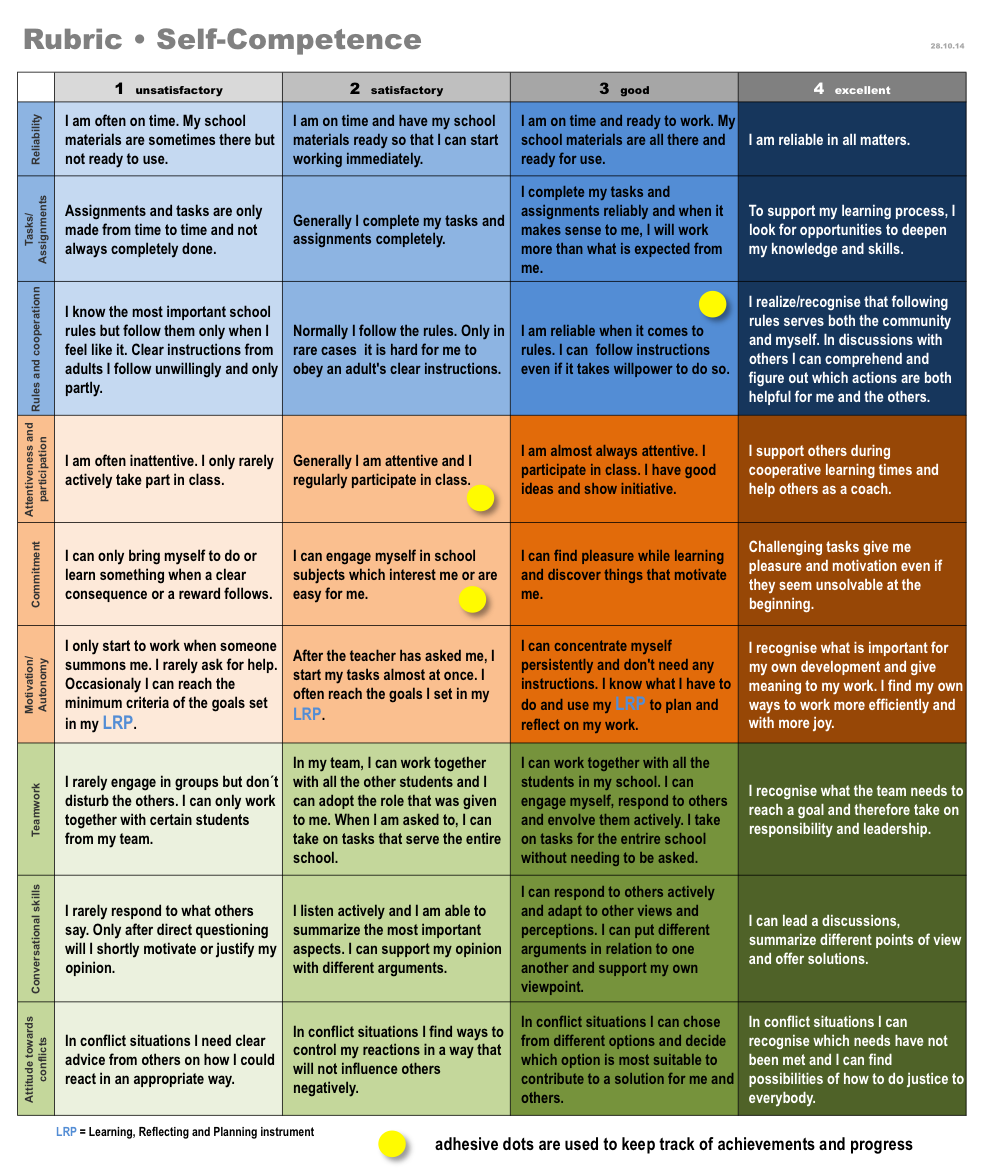
This rubric can be used in several ways. What we found most helpful in difficult classroom interventions like the one described here, is having the student situate himself and then for the teacher to give feedback on the student’s self-reflection in the most objective way possible (as a self- and peer-assessment tool). Using this tool as a way to self-reflect about the current situation and the desired future situation requires and promotes a growth mindset; it is important that the student looks at it as a way to develop himself and not as an instrument for punishment or judgment.
There are more possible outcomes from the use of this rubric. In our case, if Noah and Leon decide, for whatever reason, to make this intervention as challenging as possible for Mrs. Riesen, they might decide to position themselves in a good or excellent square when their behavior clearly doesn’t reflect their assessment.
In this case the best possible reaction would probably be to ask them what concrete behavior one would see if they were in that square, and ask them to make sure that this behavior would be noticeable for her and the other students from that point on. Starting a discussion about whether the student was right with his self-assessment or not, would not be helpful or meaningful and would end up in a power-game between teacher and student on who is ‘right’ The idea of the instrument is not about who is right, but about making the student reflect, and guiding him towards a next possible step in his development.
Making students responsible for and conscious about the impact of their decisions is an important part of the intervention
In this case Mrs. Riesen could tell Leon and Noah in a very direct way ‘It’s your choice how you deal with this situation’ or ‘I want you to realize that your decision now has an impact, and you can influence the direction of where this situation is going.” Without threatening, Mrs. Riesen could give them some options.
At itw we have installed a quiet room, called Atlantis, where one teacher is always present to guide students who are not able to concentrate or participate in the regular learning setting. So in this case a teacher could tell Leon and Noah “You can either stay in the classroom and work in a quiet way or you can go to Atlantis and try to work there.”
 Going to Atlantis can have different goals. If this new setting suffices for Leon to be able to go back to work, his new goal could be to end the task. If Noah needs this quiet place in order to calm down and deal with his emotions, this process alone could be an important goal in itself. Maybe the teacher present in Atlantis is able to reach out to him and a meaningful conversation takes place. Atlantis is not a place of punishment; it is a place to find either a good learning atmosphere or an atmosphere that helps to calm down, blow off steam or even orient oneself again.
Going to Atlantis can have different goals. If this new setting suffices for Leon to be able to go back to work, his new goal could be to end the task. If Noah needs this quiet place in order to calm down and deal with his emotions, this process alone could be an important goal in itself. Maybe the teacher present in Atlantis is able to reach out to him and a meaningful conversation takes place. Atlantis is not a place of punishment; it is a place to find either a good learning atmosphere or an atmosphere that helps to calm down, blow off steam or even orient oneself again.
By giving the students a choice, they become involved in the solution-oriented process. In tough times, it’s important to have everyone ‘on board’ and for the entire crew to think for themselves as well in order to take the necessary steps to reach the overarching goal.
Furthermore, by involving students in the process, they are obliged to think about their behavior. If the teacher would give instructions in the form of a threat, for instance “If you don’t do this now, I will send you to Atlantis”, the student would clearly and openly be put in an inferior position. By not being made able to make decisions, the student would be pushed in a corner and left no choice but to either ‘submit’ or—what happens mainly with students who don’t want to lose face in front of their friends—start a discussion in the form of a power game. Then Mrs. Riesen would find herself in an ever more difficult position.
On the other hand, if they can make a decision, this means they actively have to think about the consequences of their decisions, and learn to deal with them.
Other helpful ideas from a growth-mindset that might positively impact the intervention
- Add lightness by looking at these difficult classroom situations as learning opportunities.
- When an intervention works, develop it further and do it whenever possible. When something doesn’t work (anymore), try out something new.
- Add humor whenever possible.
Conclusion: how ‘Line-of-sight sailing’ can help teachers deal with difficult situations and help adolescents develop life skills and enhance self-awareness
When teachers start to develop the skills necessary to be more than a teacher and become a coach or a guide with a Teal mindset for their students, they will find it much easier to guide adolescents, not only during those difficult days at school, but even in finding their way in life.
In the continuing complexity of decision-making and orientation in life, students will need more guidance and coaching when it comes to finding out who they are and what they want. At itw we give our best to turn difficult situations into learning processes for everyone, in order for all students, teachers, and parents to develop and grow in their own individually-defined meaningful way.
 Ellen Even has lived in Belgium, Bahrain, and now Switzerland, and studied Educational Sciences and Culture and Development in Belgium, Sweden and Surinam. Looking for ways to integrate Non-violent Communication, Sociocracy, Solution-focused Therapy, and the Integral Theory into practice as a co-headmaster, teacher, and coach for adolescents and colleagues at ITW, one of her main intentions is a better understanding of what drives people, what makes them happy, and what helps them connect to and understand others. Her guiding question: “What could a world look like in which right and wrong lose their importance, and the focus changes towards what brings people together?” [email protected] www.itw-oberstufe.ch www.integral-learning.ch
Ellen Even has lived in Belgium, Bahrain, and now Switzerland, and studied Educational Sciences and Culture and Development in Belgium, Sweden and Surinam. Looking for ways to integrate Non-violent Communication, Sociocracy, Solution-focused Therapy, and the Integral Theory into practice as a co-headmaster, teacher, and coach for adolescents and colleagues at ITW, one of her main intentions is a better understanding of what drives people, what makes them happy, and what helps them connect to and understand others. Her guiding question: “What could a world look like in which right and wrong lose their importance, and the focus changes towards what brings people together?” [email protected] www.itw-oberstufe.ch www.integral-learning.ch
 Armin Sieber: Throughout his different roles as teacher, headmaster, OD consultant, coach or trainer, facilitating personal or organizational growth is his great passion. Together with a team of highly committed teachers and staff members at Integrale Tagesschule Winterthur, Switzerland, he embarked on the journey to explore what future-oriented education might look like. [email protected] www.itw-oberstufe.ch www.integral-learning.ch
Armin Sieber: Throughout his different roles as teacher, headmaster, OD consultant, coach or trainer, facilitating personal or organizational growth is his great passion. Together with a team of highly committed teachers and staff members at Integrale Tagesschule Winterthur, Switzerland, he embarked on the journey to explore what future-oriented education might look like. [email protected] www.itw-oberstufe.ch www.integral-learning.ch
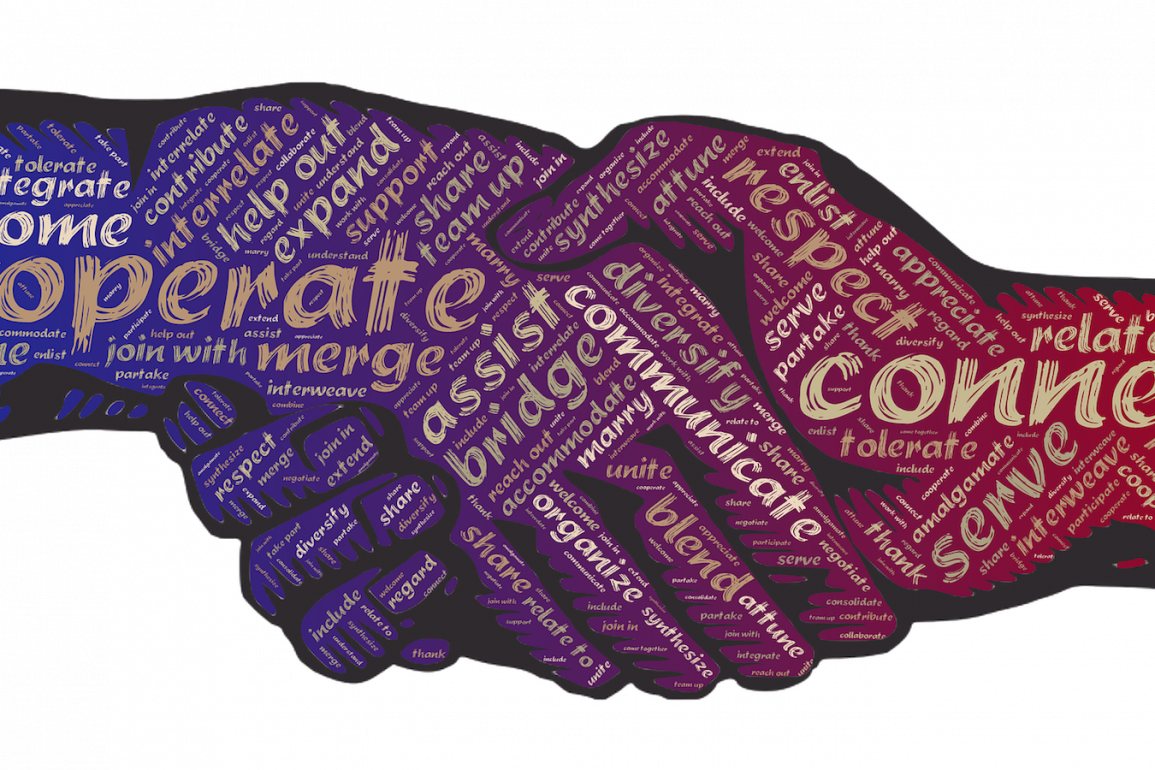




Authors Ellen and Armin updated this school’s journey in their presentation at Integral European Conference this past week. Check out to see when the recording might become available from IEC https://2022.hybrid.integraleuropeanconference.com/ Or contact the authors directly as the school is starting to become available more directly as a prototype.